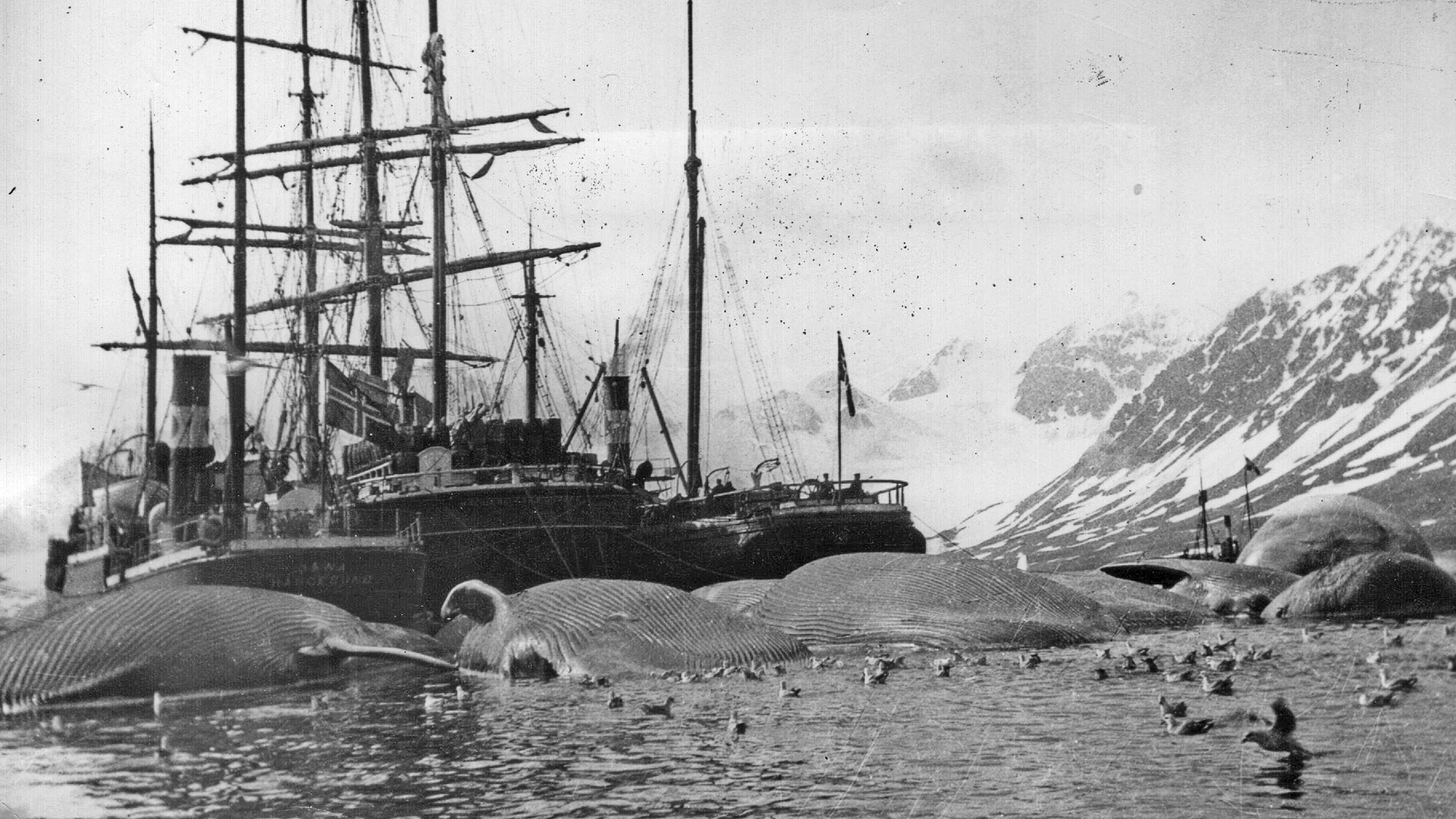
Why was whaling so big in the 19th century?
Whaling was a grisly business, but it enabled a life of comfort and ease that was at odds with this reality.

In the mid-1800s, a seaman named Charles Nordhoff found himself on the deck of a ship, coated head to toe in the fat of a recently dispatched whale. "Everything is drenched with oil. Shirts and trowsers are dripping with the loathsome stuff. The pores of the skin seem to be filled with it. Feet, hands and hair, all are full," he later wrote in a book based on his experiences. "From this smell and taste of blubber, raw, boiling and burning, there is no relief or place of refuge."
The grisly picture Nordhoff painted was a daily reality for whaling seamen of the era — but the oil that so uncomfortably coated their bodies was also the ticket to their fortune. The quest for this product sent tens of thousands of seamen into dangerous pursuit of whales between the 17th and 20th centuries. Yet capturing whales was about more than their oil alone; their behemoth bodies were a treasure trove of products that became crucial to 18th and 19th century people. Much of this was intended to enable a comfortable, refined and elegant lifestyle that seemed so at odds with the grisly, seafaring scenes it took to provide those privileges.
"There's something very romantic about the way that whaling is often portrayed in the mists of history," said Eric Jay Dolin, an expert on maritime history and author of the book "Leviathan: The History of Whaling in America" (W.W. Norton & Company, 2007). "But in reality, whaling was not romantic at all: It was a dirty, grimy, violent business — but one that was nevertheless important in the history of America." Indeed, in the 1800s, America became the epicenter of the global whaling industry. "By the 1840s, there were about 735 American whale ships out of a total worldwide of about 900," Dolin told Live Science. "And by around 1850, it was the fifth largest industry in the United States."
Related: How much of the ocean is whale pee (and worse)?
This burgeoning industry was founded on humanity's love of light — and the fact that a whale's body contained an abundance of oil to fuel the production of light. "The main use of whale oil, for most of the history of American whaling, was for illumination," Dolin said.
This oil, as Nordhoff's writing made so vividly clear, derived from whale blubber that was stripped from hunted whales and boiled down, often onboard ships, in huge copper cauldrons. "That would go into outdoor street lighting, which was a very, very important thing for civilization — the idea that the streets would be lit at night," said Michael Dyer, curator of maritime history at the New Bedford Whaling Museum in Massachusetts, a place that was a regional hub of whaling in the 18th and 19th centuries.
The blubber of sperm whales, in particular, yielded a fine, straw-colored oil that proved to have exceptional qualities, which made it ideal for illuminating lighthouses that, conveniently, would bring whaling ships home. "It was really important for the functioning of maritime states, especially the United States, which had an extensive sperm whale fishery," Dyer told Live Science. "These lighthouses had to burn, and the oil had to burn perfectly every time. So the government would actually send inspectors and buyers to the seaports to buy sperm oil."
Sign up for the Live Science daily newsletter now
Get the world’s most fascinating discoveries delivered straight to your inbox.
Whale oil became the hot-ticket item of its day. It made its way into miner's headlamps and became a go-to lubricant for guns, watches, clocks, sewing machines and typewriters, Dyer said. What's more, sperm oil can withstand high temperatures, leading to its use as a lubricant in fast-moving machinery. As Dolin put it, "Whale oil was used to grease the gears of the Industrial Revolution, essentially."
But blubber wasn't the only source of this oily bounty. Contained within the head cavities of sperm whales was an even more valuable ingredient: a clear, liquid wax that was dubbed "spermaceti," which may be involved in the whale's sound production and echolocation. Whalers knew that if they could prize open the head and scoop out bucketfuls of the mysterious wax, it could fetch a much higher price than regular oil, on account of its smokeless and odorless burn.
"Benjamin Franklin liked to read by spermaceti candle light," Dolin noted. The higher price of spermaceti candles made them a symbol of status for wealthier members of society, across America and Europe.
Related: Why do whales sing?
The byproducts of whale-oil refinement also made their way into soap. And later, in the 20th century, whale oil was even used in the production of edible goods like margarine. But though oil was undoubtedly the industry's most valuable commodity, there were other products to salvage from the gigantic corpse of a whale. One of these, surprisingly, made its mark in the fashion industry: baleen.
These are the plates of dense, fibrous bristles that hang from the upper jaws of baleen whales and which the animals used to filter tiny crustaceans, plankton and fish from the sea. In the fashion industry, the bony plates from which the bristles hung provided the perfect combination of sturdiness and flexibility needed to craft round skirt hoops and the structured boning inside corsets. That gave women the hourglass figures that were so in vogue at the time.
Baleen found a use, too, in providing the ribbing for umbrellas and parasols, also finding a place in women's hats. While it had started out as a byproduct of whaling, the market for baleen became a driver of the whaling industry, itself: "Fashion maintained the whaling industry, right up to the 1890s," Dyer said.
These plates were also transformed into fishing poles and crossbows; they were made into buggy whips and the springs on horse-drawn carriages. "Anybody who had a horse and buggy needed a buggy whip — so you're talking millions. It was a big industry," Dyer said. The rigid baleen was even used in medical scenarios, for setting broken bones, he added.
Another valuable commodity was ambergris, a substance found in the intestines of sperm whales that was, and still is, used to make perfume, including the luxury fragrance Chanel No. 5.
By offering several conveniences and comforts that became essential to modern life, the commercial value of whaling in the United States ballooned. Dolin gave an example from his book: "In 1853, the industry's most profitable year, the fleet killed more than 8,000 whales, to produce 103,000 barrels of sperm oil; 260,000 barrels of whale oil; and 5.7 million pounds [2.6 kilograms] of baleen, all of which generated sales of $11 million."
Yet, luckily for whales — though less fortunately for those who depended on their pursuit for an income — this era of intense exploitation didn't last much longer in America, which had had, up until this period, the biggest whaling industry in the world. By the late 1850s, petroleum oil had been discovered in the country, and kerosene began to replace the oil eked from blubber as a source of light. Whaling was still important for other industries, like fashion, which carried it into the late 1800s in the United States. But over time baleen was replaced by materials that could be manufactured on land, instead of being hunted down in the sea.
Related: Tale of 2 tails: Why do sharks and whales swim so differently?
By the 1900s, America’s whaling industry had been overtaken by other countries. During this period, technological advances in shipping and harpooning mechanized the activity, pushing whale populations to the brink. That prompted global whaling regulations after World War II, and in the decades to come, countries around the world went on to almost unanimously place a moratorium on commercial whaling.
Today, as a result, we see whales as the charismatic and beautiful creatures that they are, deserving of conservation, Dyer said. But both he and Dolin noted that this doesn't mean we should cast judgement on the whalers of centuries gone by. "I am not going to view what Yankee whalemen did through the lens of modernity," Dolin said. Whaling in the 18th century brought light and warmth to humans, essentials that enabled progress and growth. And today, whether or not we like to acknowledge it, we live with the benefits enabled by that history.
"Understanding the significance of the oceans to human life is probably the thing I want people to take away from understanding whaling history," Dyer said. "This was an industrial maritime endeavor that took place all around the world, and it created the modern world that we know today."
- Why do whales beach themselves?
- What's the world's largest whale?
- How did whales' ancestors leave land behind?
Originally published on Live Science.

Emma Bryce is a London-based freelance journalist who writes primarily about the environment, conservation and climate change. She has written for The Guardian, Wired Magazine, TED Ed, Anthropocene, China Dialogue, and Yale e360 among others, and has masters degree in science, health, and environmental reporting from New York University. Emma has been awarded reporting grants from the European Journalism Centre, and in 2016 received an International Reporting Project fellowship to attend the COP22 climate conference in Morocco.










